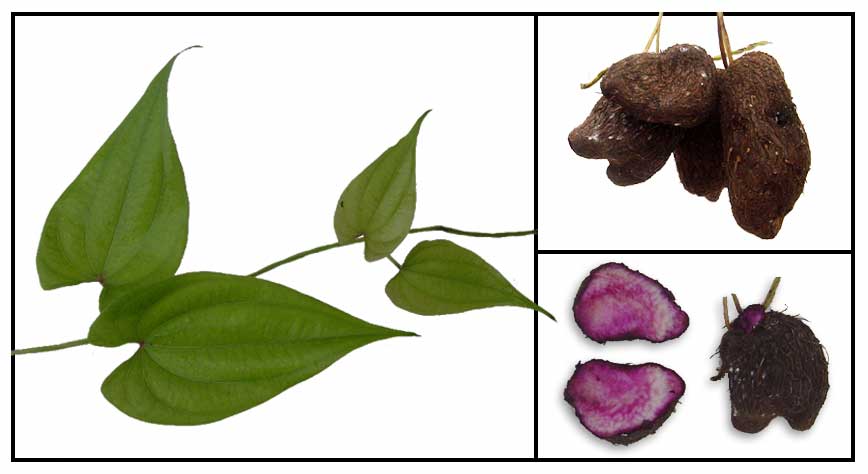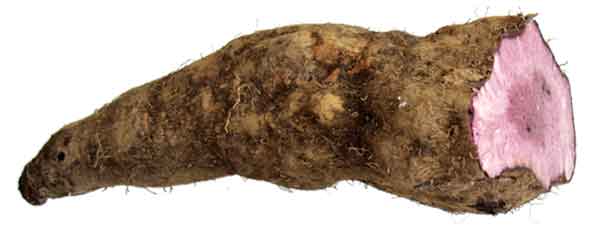|

Botany
Dioscorea alata is slender creeping
vine reaching a length of several meters. The leaf-stalk slightly
purple at both points of attachment. Tubers are usually bright lavender in color, occasionally white. Root is tumorous, often
with small axillary tubers.
 Distribution Distribution
- Throughout the
Philippines in thickets at low and medium altitudes.
- Cultivated.
Constituents
- Main component are complex carbohydrates.
- Tuber yields 1-4% protein, very low fat, and high fiber content.
- Yam tuber yields per 100 g: calories 118 kcal (494 kJ)., carbohydrates 27.89 g, protein 1.53 g, fat 0.17g, fiber 4.1g, vitamin C 17.1mg, thiamine (vitamin B1) 0.11 mg, riboflavin (vit B2) (0.03 mg), niacin (vit B3) 0.55 mg, pantothenic acid 0.31 mg, pyridoxine (vit B6) 0.29 mg, folate 23 mcg, calcium 17 mg, vitamin K 2.3 µg, magnesium 21 mg, phosphorus 55mg, sodium 9 mg, potassium 816, iron 0.54 mg, zinc 0.24 mg, copper 0.18, selenium 0.70 mcg, water 69.60 g. (17) (19)
- Study of 20 varieties of Dioscorea alata yielded total dietary fiber (TDF) ranging from 4.10 to 11.00%, dry matter composition 19.10 to 33.80%, amylose 27.90 to 32.30%. Mineral content in mg/kg(-1) showed zinc 10.10 to 17.60, potassium 10,550-20,000, Na 83-131, Ca 260-535, and Mg 390-595. (see study below) (18)
- Phytochemical screening of tuber extracts yielded alkaloids. tannins, phenolics, glycosides, saponins, resins, terpenoids, and anthraquinones. (28)
- The aqueous extract of D. alata peel contained 1.95 ± 0.05% flavonoids, 2.18 ± 0.03% tannins, 0.25% alkaloids, and 3.96 ± 0.06% saponins, while the ethanolic extract yielded 1.85 ± 0.14% flavonoids, 1.33 ± 0.04% tannins, 0.60% alkaloids, and 5.36 ± 0.01% saponins. (see study below) (30)
- Phytochemical screening of leaves yielded saponin, tannin, flavonoid, reducing sugar, and glycosides in the leaves. Bulbils yielded saponin, tannin, terpenoids, and reducing sugar. (see study below) (33)
Properties
- Considered cholagogue, antispasmodic, diuretic.
- Studies have suggested antioxidant, estrogenic, cholesterol lowering, hypolipidemic, hepatoprotective, nephroprotective properties.
- Caution: High potassium content suggests caution in use by patients with renal disease.
Parts utilized
Tubers
Uses
Nutrition / Edibility
- Tuber is eaten as vegetable.
- Tubers are rich in B vitamins, especially thiamine and niacin.
Folkloric
- Powdered tubers used as
a remedy for piles, gonorrhea, and applied externally to sores.
- In Assam, tuber paste applied on cancerous wounds; used for leprosy, gonorrhea, skin diseases and high blood pressure.
(15)
- Used to treat diarrhea, frequent urination, cough, diabetes mellitus, burns and scalds.
- In traditional Chinese medicine, used to treat diarrhea, fortify the spleen and kidneys.
- Used to relieve dysmenorrhea.
Studies
• Antioxidant Activity: • Local Root Crops as Antioxidant: A 2006 study of commonly
consumed roots crops in the Philippines (Kamote, Ipomoea
batata; ubi, purple yam, Dioscorea alata; cassava, Manihot esculenta;
taro or gabi, Colocasia esculenta; carrot, Daucus carota; yacon (Smallanthus
sonchifolius) showed them to be rich sources of phenolic compounds with
antioxidant activity, highest in sweet potato, followed by taro, potato,
purple yam and lowest in the carrot. • Study showed hyperhomocysteinemia induced by methionine could be reversed by D alata feeding. D alata feeding showed antioxidative effects.
• Anti-Fenton Reaction Activity / Copper-chelating and absorbing capability:
Study of three taxa of D. alata showed significant anti-Fenton reaction
activity, similar to EDTA. Study showed copper-chelating and absorbing
capability of yam tuber pulp. (1)
• Bowel function benefits: Study
showed 25% to 59% yam diet increased fecal mass and SCFA (short-chain
fatty acid) output, modulated fecal microflora and thickened caecal
mucosal lining in mice. (3)
• GI function / Antioxidant:
Rhizome extract of DA has been shown to possess radical scavenging
activity. Study showed both Chinese yam and Japanese yam were beneficial
for intestinal health and oxidation prevention. (4)
• Estrogenic activity: Extract
study isolated new and known compounds and showed activation of estrogen
receptors alpha and beta. Results suggest beneficial effect of yam for
menopausal women.
• Dioscorin / Angiotensin converting enzyme inhibition
/ Antihypertensive: Dioscorin, the tuber storage protein of yam
and its hydrolysates presents potential use for hypertension control. (5)
• Cholesterol lowering: Study
showed reducing effects of 50% yam diet on plasma and hepatic cholesterol
levels probably through inflated fecal fat and steroid excretion. (6)
• Cytokine-Mimetic property:
Study that from extracts of yam roots and leaves( D alata),
taro roots (Colocasia esculenta), buyo leaf (Piper betle) showed strongly
stimulated proliferation of both bone marrow cells and splenocytes,
significantly increasing cell concentrations. (7)
• Disocorin / Cytokine Expression / TLR4-Signaling Pathway: TLR4 is a promising target for immunomodulating drugs and TLR4 agonists have therapeutic potential for treating immune diseases and cancer. Study shows dioscorin is a novel TLR4 activator and induces macrophage activation via TLR4-signaliing pathways.
• Estrogenic effect in menopausal
women : In a study of menopausal women with rice staple
diet replaced by yam (D alata) for 30 days showed improvement in status
of sex hormones (estrone, sex hormone binding globulin, estradiol),
blood lipids and antioxidants suggesting possible benefits in reducing
breast cancer and cardiovascular disease in postmenopausal women. (8)
• Bone-Protective Effect: Yam prevented loss of BMD (bone mineral density) and improved calcium status without stimulating uterine hypertrophy in ovariectomized mice. TNG yam may be beneficial for postmenopausal women for preventing bone loss. (9)
• Hypo-Triglyceridemic Effect: Yam may inhibit the acute induction of hypertriglyceridemia and liver enlargement in rats fed a high cholesterol diet. (10)
• Renal Protective / Hepatoprotective: Pharmacologic and biochemical studies showed yam have both renal protective and hepatic fortification effects in acetaminophen rats. Results provide basis for the use of yam in traditional Chinese medicine for deficiencies of liver-yin and kidney-yin. (12)
• Potential Health and Nutritional Benefits: Study showed the potential use of D. alata as a functional food to supplement the fiber and mineral needs of consumers, and underlines the need to exploit its used in food fortifications and formulations. (see constituents above) (18)
• Attenuation of Renal Interstitial Cellular Fibrosis: Renal interstitial fibrosis is characterized by extracellular matrix (ECM) synthesis. Study evaluated the fibrosis regulatory effect of Dioscorea alata. Epithelial-mesenchymal transition (EMT) in kidneys is driven by regulated expression of fibrogenic cytokines such as transforming growth factor-beta (TGF-ß). Study suggests Dioscorea alata might act as a novel fibrosis antagonist, which acts partly by down regulating the TGF-ß/smad signaling pathway and modulation EMT expression. (20)
• Antioxidant / Flavonoid Content: Study of methanol extract for total phenolics and flavonoid content yielded 0.68 g/100g and 1.21 g/100g, respectively. An ethanol extract showed strong DPPH radical scavenging activity. The maximum inhibitory concentration (IC50) in all models viz., DPPH, hydroxyl, superoxide, and ABTs radical cation scavenging activity of tuber were 27.16, 26.12, 30.65, and 25.53 µg/mL respectively at 1 µg/mL concentration. (21)
• Antidiabetic / Tubers: Study evaluated the antidiabetic effect of an ethanolic extract of D. alata in glucose loaded and alloxan induced diabetic rats. Results showed showed significant antidiabetic activity evidenced by a highly significant reduction (p<0.001) in blood glucose levels at doses of 100 and 200 mg/kg, respectively. (23)
• Anti-Allergic: Study evaluated the effects of ethanol extract of tuber of D. alata on allergic models of mice induced by Ovalbumin using measurements of IgE, IL-4, and TNF-α level. EEDA dose of 0.62 and 1.24 g/kg was able to decrease the IgE level and EEDA dose of 1.24 g/kg was able to increase TNF-α levels. (24)
• Immunostimulatory / Mucilages: Study evaluated purified mucilages from three Taiwanese yam cultivars to evaluated the immunostimulatory effects on murine innate and adaptive immunity. Results showed all three mucilages could elevate the number of T. helper cells in peripheral blood and enhance the phagocytic activity of granulocyte, monocytes, and macrophages, both ex vivo and in vitro tests. The production of specific anti-ovalbumin (OVA) antibody and OVA-stimulated splenic proliferation were all enhanced by all mucilage groups. Results suggested the tuber mucilage might function as an immunostimulatory substance. (25)
• Protective Effect in Aniline-Induced Splenic Toxicity: Study evaluated the protective effects of ethanolic extract of D. alata on hematological and biochemical changes in aniline-induced spleen toxicity in rats. Results suggest the involvement of oxidative and nitrosative stress in aniline-induced splenic toxicity and DA protects the rats from toxicity, which may be due to its antioxidant property and the presence of different phytochemicals. (26)
• Immunomodulatory / Steroid Saponin / Tuber: Study examines the potential of steroid saponin in purple yam tuber as an immunomodulatory agent. Literature review suggests the steroid saponins in the tuber has a potency as immunomodulatory agent. (27)
• Antibacterial / Cytotoxicity / Tubers: Study evaluated tuber extracts for antimicrobial and cytotoxicity properties. Extracts showed antimicrobial against against both gram negative and gram positive bacterial strains by disc diffusion study. The extracts exhibited cytotoxicity against Dalton's lymphoma ascites (DLA) cells by Trypan blue method. (see constituents above) (28)
• Antiosteoporotic / Mesenchymal Stem Cells Differentiation for Bone Formation: Study evaluated the effect of an ethanol extract of rhizomes of D. alata L. cv. Phyto. Dispo85E, on bone formation. The Dispo85E increased the activity of alkaline phosphatase (ALP) and bone nodule formation in primary bone marrow culture. It stimulated pluripotent stems cells to differentiate into osteoblasts rather than adipocytes. Dispo85E promotes osteoclastogenesis and ameliorates deterioration of trabecular bone miner density. Results suggest Dispo85E is a botanical drug with a novel mechanism with potential for osteoporosis therapy. (29)
• Antifungal / Peels: Study evaluated the phenolic composition and antifungal activity of aqueous and ethanolic extracts of peels of Dioscorea alata and D. bulbifera. The extracts of yam peels exhibited various antifungal activities in a dose dependent manner and at 40% concentration exhibited higher inhibitory action on Botryodiploidia theobromae than standard Griseofulvin. (see constituents above) (30)
• Anti-Inflammatory / Tuber: Study evaluated the anti-inflammatory activity of hydomethanol extract of D. alata tuber. The extract inhibited the expression of NO and TNF-a with IC50 of 134.51± 6.75 and 113.30 ± 7.44 µg/mL, respectively. IC60s for inhibition of total COX, COX-1, COX-2 activities and PGE2 level were 41.96 ± 3.07, 141.41 ± 8.99, 32.50 ± 1.69, and 186.34 ± 15.36 µg/mL, respectively. Results suggest significant down-regulation of pro-inflammatory signals in a gradual manner. (31)
• Reduction of Body Weight and Fasting Blood Glucose: Study evaluated the effect of Dioscorea alata tubers on food intake, blood glucose and body weight in normal non-diabetic state in male Wistar rats. Results showed significant (p<0.05) reduction of f food intake, weight and blood glucose level. Study suggests further research for active constituent and the potential for a therapeutic option in the management of diabetes. (32)
• Antibacterial / Tubers: Study evaluated the antibacterial activity of various tuber extracts against Vibrio cholerae, Salmonella typhimurium, Shigella flexneri, Streptococcus pyogenes, and Streptococcus mutans. Extract showed highest activity against S. pyogenes. (33)
• Antidepressant / Anxiolytic: Study evaluated the neuropharmacological activities of methanolic extract of D. alata tubers using behavioral mice models, elevated plus maze and hole board test for anxiolytic activity and open field, hole cross, tail suspension, and force swimming test for exploratory activities of mice. Results showed significant anxiolytic-like effect in mice and moderate antidepressant activity. (34)
• Mucilage as Binder for Tablet Formulations: Study evaluated the binding efficiency of mucilage extracted from R. alata by comparing it to two established binders. The physiochemical properties of paracetamol granules and tablets produced using D. alata were comparable with those of acacia gum and HPMC (hydroxy methyl cellulose). Results showed good binding properties and can be used as a binder in tablet formulations. (35)
Availability
Widcrafted. |



 Distribution
Distribution 

